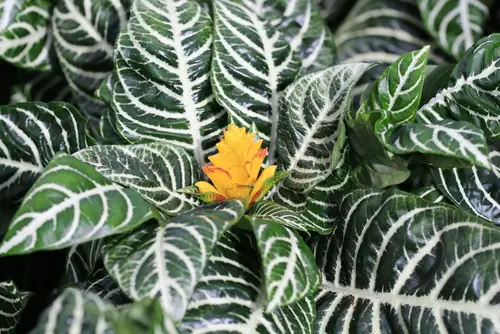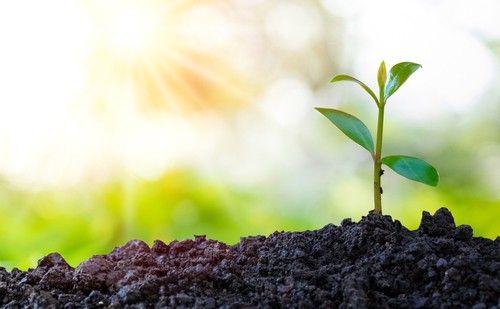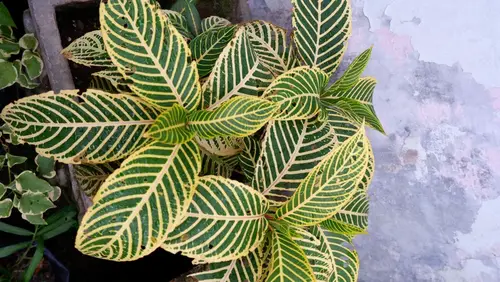Zebra plants, also known as Aphelandra Squarrosa, are beautiful tropical indoor plants that are highly sought after for their stunning foliage. However, it can be frustrating to see zebra plant leaves turning brown, especially if you are unsure of the cause.
There are several reasons why zebra plant leaves may turn brown, including watering issues, lighting problems, and humidity levels. Understanding the needs and requirements of your zebra plant is crucial to keeping it healthy and thriving.
In this article, we will explore the common causes of brown leaves in zebra plants and provide solutions to help you revive your plant. We will cover topics such as watering needs, soil and potting requirements, light and temperature conditions, and the role of fertilizers and nutrients.
By the end of this article, you will have a better understanding of how to care for your zebra plant and keep its foliage looking lush and healthy.
Key Takeaways
- Understanding the specific requirements of your zebra plant is crucial to its health and vitality.
- Watering issues, lighting problems, and humidity levels are common causes of brown leaves in zebra plants.
- Proper care and maintenance, including pruning and pest control, can help keep your zebra plant thriving.
Learn more about plant care from these other posts:
- Why Is My Watch Chain Plant Turning Brown?
- Schefflera Leaves Turning Brown
- Why Is My Umbrella Plant Turning Brown?
Understanding Zebra Plant

Zebra Plant, scientifically known as Calathea zebrina, is a tropical plant native to the rainforests of Brazil. It is a popular houseplant due to its attractive foliage and easy-to-care-for nature.
Zebra Plant in Natural Habitat
In its natural habitat, the Zebra Plant grows in the understory of tropical rainforests. It prefers low to medium light and high humidity levels. The plant grows up to 3 feet tall and has large, oval-shaped leaves with distinctive zebra-like stripes. The leaves are green on top and purple on the bottom, which helps the plant absorb more light.
Zebra Plant as Houseplant
As a houseplant, the Zebra Plant is relatively easy to grow and care for. It can thrive in low to medium light conditions and prefers well-draining soil. The plant is sensitive to overwatering and can develop root rot if the soil is too moist. It is best to water the plant when the top inch of soil is dry to the touch.
Proper care is essential to keep the Zebra Plant healthy. The plant needs a consistent temperature between 60-75°F and high humidity levels. It is recommended to mist the plant regularly or place a humidifier nearby.
Why Is My Zebra Plant Leaves Turning Brown – 4 Common Problems
Zebra plants are known for their striking leaves and colorful flowers. However, sometimes the leaves turn brown, which can be a sign of stress or disease. Here are some common causes of brown leaves in zebra plants:
1. Overwatering and Underwatering
Overwatering is one of the most common causes of brown leaves in zebra plants. When the soil is constantly wet, the roots can rot, which can cause the leaves to turn brown and eventually die.
On the other hand, underwatering can also cause the leaves to turn brown and dry out. It is important to find the right balance of watering to avoid both overwatering and underwatering.
2. Temperature Stress

Zebra plants are tropical plants and prefer warm temperatures between 65 and 80 degrees Fahrenheit. If the temperature drops below 60 degrees Fahrenheit, the leaves can turn brown and start to die. Similarly, if the plant is exposed to direct sunlight or cold drafts, the leaves can also turn brown.
3. Lighting Conditions
Zebra plants prefer bright, indirect light. If the plant is not getting enough light, the leaves can turn brown and start to die. On the other hand, if the plant is exposed to too much direct sunlight, the leaves can also turn brown and dry out.
4. Pests and Diseases
Zebra plants can be susceptible to pests and diseases, which can cause the leaves to turn brown. Common pests that can affect zebra plants include spider mites, mealybugs, and scale insects. Diseases such as root rot and leaf spot can also cause the leaves to turn brown.
Watering Needs of Zebra Plant
Zebra plants are native to tropical regions, and they require proper watering to maintain their health and beauty. In this section, we will discuss the watering needs of zebra plants, how to identify overwatering and underwatering, and the proper watering technique.
1. Identifying Overwatering
Overwatering is a common problem that can cause zebra plant leaves to turn brown. Signs of overwatering include yellowing leaves, mushy stems, and a foul odor. If the soil is too wet, the roots of the plant can rot, and this can lead to the death of the plant.
2. Identifying Underwatering
Underwatering is another common problem that can cause zebra plant leaves to turn brown. Signs of underwatering include dry soil, wilting leaves, and slow growth. If the plant is not watered enough, it can become stressed, and this can lead to brown leaves.
3. Proper Watering Technique

Proper watering technique is essential to maintain the health of your zebra plant. Here are some tips to help you water your plant correctly:
- Water your zebra plant deeply, but not too often. The soil should be moist, but not waterlogged.
- Water your plant when the top inch of soil is dry to the touch. Stick your finger into the soil to check the moisture level.
- Use room temperature water to avoid shocking the plant.
- Use a well-draining soil mix to prevent water from sitting in the bottom of the pot.
- Avoid watering the leaves of the plant. Water the soil directly to prevent fungal growth.
Soil and Potting Requirements
Zebra plants require well-draining soil and a suitable potting container. The soil should be porous and airy to allow for proper root development and drainage. It is recommended to use a mixture of organic matter and cacti soil to create the ideal growing environment for the zebra plant.
When choosing a potting container, it is important to ensure that it has adequate drainage holes to prevent water from accumulating at the bottom of the container. This can lead to water-logged soil, which can cause the zebra plant’s leaves to turn brown.
If the current container does not have drainage holes, it is recommended to repot the plant into a container that does.
If the soil in the current container is compact, it may be necessary to repot the zebra plant into a larger container with fresh soil. When repotting, it is important to ensure that the new container is only slightly larger than the previous one to prevent overwatering.
Additionally, it is important to ensure that the new soil used for repotting is pathogen-free to prevent the spread of diseases.
The pH balance of the soil is also important for the zebra plant’s growth. The ideal pH range for the zebra plant is between 6.0 and 7.0. If the pH balance of the soil is too high or too low, it can cause the zebra plant’s leaves to turn brown.
It is recommended to test the soil’s pH balance regularly and adjust it as necessary using appropriate soil amendments.
Light and Temperature Conditions

Zebra plants prefer bright but indirect light conditions. Direct sunlight can cause sun stress, which leads to brown spots on the leaves. On the other hand, insufficient light can cause the leaves to turn yellow and drop off. Therefore, it is essential to find the right balance of light for your zebra plant.
During the summer months, it is best to place your zebra plant in partial shade or filtered light to prevent sun stress. In contrast, during the winter months, when the sun is scarce, it is best to move your plant closer to a window that receives more light.
If you notice that your zebra plant is not getting enough light, you can supplement it with a grow light.
Temperature is another crucial factor that can affect the health of your zebra plant. These plants prefer temperatures between 65-75°F during the day and 60-65°F at night. Temperatures above 75°F can cause the leaves to turn brown and dry out. In contrast, temperatures below 60°F can cause the leaves to drop off.
Cold drafts can also cause brown spots on the leaves. Therefore, it is best to keep your zebra plant away from air vents, either hot or cold. If you live in a cold climate, you can protect your plant by moving it away from windows during the winter months.
Humidity and Its Effects
Zebra plants are native to rainforests where humidity levels are high. Therefore, it is essential to maintain proper humidity levels to keep your zebra plant healthy. Low humidity levels can cause the tips and edges of the leaves to turn brown, and the overall growth of the plant can be stunted.
When the air is dry, it can cause the moisture in the leaves to evaporate, leading to brown and crispy edges. To prevent this, it is recommended to keep the humidity levels between 40-60%. If the humidity level in the room is low, the use of an electric humidifier can help maintain the required levels.
Another way to increase humidity is by placing a pebble tray near the zebra plant. Fill the tray with water and place pebbles in it. The water will evaporate, increasing the humidity levels around the plant. It is important to ensure that the pot is not directly in contact with the water, as this can cause the roots to rot.
In addition to maintaining proper humidity levels, it is also important to avoid sudden changes in humidity. For example, placing the plant near an air conditioner or heater can cause the humidity levels to fluctuate rapidly, which can cause stress to the plant.
Role of Fertilizers and Nutrients

Fertilizers play a crucial role in the growth and development of zebra plants. They provide essential nutrients that are needed for the plant to thrive. However, over-fertilization can cause more harm than good.
Using too much fertilizer can cause the zebra plant’s leaves to turn brown. This is because excess fertilizer can cause a build-up of salts in the soil, which can damage the roots of the plant. It is important to follow the instructions on the fertilizer package and not exceed the recommended dosage.
Using a balanced fertilizer is also important for the health of the zebra plant. A balanced fertilizer contains equal amounts of nitrogen, phosphorus, and potassium. These three nutrients are essential for plant growth and development, and a lack of any one of them can cause problems for the zebra plant.
During the growing season, which is from spring to fall, it is recommended to fertilize the zebra plant every two weeks. However, during the winter months, the frequency should be reduced to once a month. It is important to use the correct amount of fertilizer, as using too much or too little can cause problems for the zebra plant.
Pruning and Maintenance
Zebra plants require regular pruning to maintain their shape and promote healthy growth. Pruning can also help to remove damaged or diseased leaves, which can turn brown and detract from the plant’s beauty. It is important to use clean, sharp pruning shears to prevent damage to the plant and to make clean cuts.
When pruning a zebra plant, it is important to trim only the damaged or diseased leaves, as cutting healthy leaves can slow the plant’s growth and reduce its overall health. It is also important to avoid pruning too much at once, as this can shock the plant and cause it to stop growing altogether.
In addition to regular pruning, zebra plants require regular maintenance to keep them healthy and beautiful. This includes watering the plant regularly, but not too much, as overwatering can cause the leaves to turn brown and wilt.
It is also important to fertilize the plant regularly, using a balanced fertilizer that is designed for indoor plants.
As zebra plants age, they may begin to lose their leaves and take on a more sparse appearance. This is a natural part of the aging process, and can be managed through regular pruning and maintenance. It is also important to keep the plant in a well-lit area, as too little light can cause the leaves to turn brown and fall off.
Dealing with Pests and Diseases
Zebra plants are generally hardy and not prone to pests and diseases, but they can still be affected by a few common issues. Here are some of the most common pests and diseases that can cause zebra plant leaves to turn brown and how to deal with them:
Pests

Spider Mites
Spider mites are tiny pests that can infest zebra plants and suck the sap out of the leaves, causing them to turn brown and dry out. To get rid of spider mites, use a solution of insecticidal soap and water and spray it on the leaves. Repeat this process every few days until the spider mites are gone.
Mealybugs
Mealybugs are another common pest that can infest zebra plants and cause the leaves to turn brown and wilt. To get rid of mealybugs, use a cotton swab dipped in rubbing alcohol to wipe them off the leaves. Repeat this process every few days until the mealybugs are gone.
Diseases
1. Leaf Spots
Leaf spots are caused by a fungal infection and can cause the leaves of zebra plants to turn brown and yellow. To prevent leaf spots, make sure to water your zebra plant from the bottom and avoid getting the leaves wet. If your zebra plant does get leaf spots, remove the affected leaves and treat the plant with a fungicide.
2. Wilting
Wilting can be caused by overwatering or underwatering your zebra plant. If your zebra plant is wilting, check the soil moisture level and adjust your watering accordingly. Make sure to water your zebra plant thoroughly but allow the soil to dry out between waterings.
3. Yellowing Leaves
Yellowing leaves can be caused by a variety of issues, including nutrient deficiencies, overwatering, and poor soil drainage. To prevent yellowing leaves, make sure to fertilize your zebra plant regularly and provide it with well-draining soil.
4. Mushy Leaves
Mushy leaves can be caused by overwatering your zebra plant or by a bacterial or fungal infection. To prevent mushy leaves, make sure to water your zebra plant only when the soil is dry and avoid getting the leaves wet. If your zebra plant does get mushy leaves, remove the affected leaves and treat the plant with a fungicide.
Frequently Asked Questions
What causes brown spots on zebra plant leaves?
Brown spots on zebra plant leaves can be caused by various factors, including overwatering, underwatering, direct sunlight, low humidity, and fungal infections.
To determine the cause of the brown spots, check the soil moisture level, lighting conditions, and humidity levels. If the soil is too wet or too dry, adjust the watering schedule accordingly.
If the plant is exposed to direct sunlight, move it to a shaded area. If the humidity levels are low, consider using a humidifier or placing a tray of water near the plant.
Why are my zebra plant leaves turning yellow?
Yellowing of zebra plant leaves can be a sign of overwatering, underwatering, or nutrient deficiency. Check the soil moisture level and adjust the watering schedule accordingly.
If the soil is too wet, allow it to dry out before watering again. If the soil is too dry, water the plant thoroughly. To address nutrient deficiency, use a balanced fertilizer and follow the manufacturer’s instructions.
How do I know if my zebra plant is overwatered?
Overwatering can cause the zebra plant’s leaves to turn yellow or brown and become mushy. The soil may also have a foul smell and appear waterlogged.
To avoid overwatering, check the soil moisture level regularly and water the plant only when the top inch of soil feels dry to the touch.
Why are my zebra plant leaves drooping?
Zebra plant leaves can droop due to underwatering, overwatering, or exposure to cold temperatures. Check the soil moisture level and adjust the watering schedule accordingly.
If the soil is too dry, water the plant thoroughly. If the soil is too wet, allow it to dry out before watering again. If the plant is exposed to cold temperatures, move it to a warmer location.
What does an underwatered zebra plant look like?
An underwatered zebra plant can have dry, crispy leaves that may turn yellow or brown. The soil may also be dry and pull away from the edges of the pot.
To avoid underwatering, check the soil moisture level regularly and water the plant thoroughly when the top inch of soil feels dry to the touch.
How often do you water zebra plants?
Zebra plants should be watered when the top inch of soil feels dry to the touch. The frequency of watering depends on various factors, including the temperature, humidity, and lighting conditions.
In general, zebra plants should be watered once a week during the growing season and once every two weeks during the dormant season. However, it is important to check the soil moisture level regularly and adjust the watering schedule accordingly.

Hey, I’m Lisa and I’ve been an avid gardener for over 30 years. I love writing, talking and living in the garden! Feel free to connect with me on my socials below


